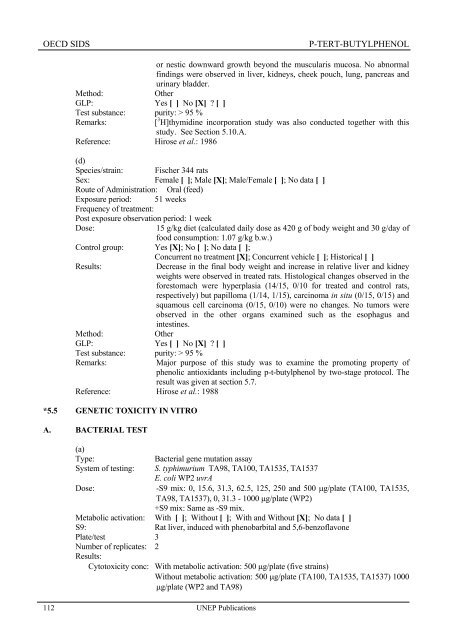p-Tert-Butylphenol - UNEP Chemicals
p-Tert-Butylphenol - UNEP Chemicals
p-Tert-Butylphenol - UNEP Chemicals
Create successful ePaper yourself
Turn your PDF publications into a flip-book with our unique Google optimized e-Paper software.
OECD SIDS P-TERT-BUTYLPHENOL<br />
112<br />
or nestic downward growth beyond the muscularis mucosa. No abnormal<br />
findings were observed in liver, kidneys, cheek pouch, lung, pancreas and<br />
urinary bladder.<br />
Method: Other<br />
GLP: Yes [ ] No [X] ? [ ]<br />
Test substance: purity: > 95 %<br />
Remarks: [ 3 H]thymidine incorporation study was also conducted together with this<br />
study. See Section 5.10.A.<br />
Reference: Hirose et al.: 1986<br />
(d)<br />
Species/strain: Fischer 344 rats<br />
Sex: Female [ ]; Male [X]; Male/Female [ ]; No data [ ]<br />
Route of Administration: Oral (feed)<br />
Exposure period: 51 weeks<br />
Frequency of treatment:<br />
Post exposure observation period: 1 week<br />
Dose: 15 g/kg diet (calculated daily dose as 420 g of body weight and 30 g/day of<br />
food consumption: 1.07 g/kg b.w.)<br />
Control group: Yes [X]; No [ ]; No data [ ];<br />
Concurrent no treatment [X]; Concurrent vehicle [ ]; Historical [ ]<br />
Results: Decrease in the final body weight and increase in relative liver and kidney<br />
weights were observed in treated rats. Histological changes observed in the<br />
forestomach were hyperplasia (14/15, 0/10 for treated and control rats,<br />
respectively) but papilloma (1/14, 1/15), carcinoma in situ (0/15, 0/15) and<br />
squamous cell carcinoma (0/15, 0/10) were no changes. No tumors were<br />
observed in the other organs examined such as the esophagus and<br />
intestines.<br />
Method: Other<br />
GLP: Yes [ ] No [X] ? [ ]<br />
Test substance: purity: > 95 %<br />
Remarks: Major purpose of this study was to examine the promoting property of<br />
phenolic antioxidants including p-t-butylphenol by two-stage protocol. The<br />
result was given at section 5.7.<br />
Reference: Hirose et al.: 1988<br />
*5.5 GENETIC TOXICITY IN VITRO<br />
A. BACTERIAL TEST<br />
(a)<br />
Type: Bacterial gene mutation assay<br />
System of testing: S. typhimurium TA98, TA100, TA1535, TA1537<br />
E. coli WP2 uvrA<br />
Dose: -S9 mix: 0, 15.6, 31.3, 62.5, 125, 250 and 500 µg/plate (TA100, TA1535,<br />
TA98, TA1537), 0, 31.3 - 1000 µg/plate (WP2)<br />
+S9 mix: Same as -S9 mix.<br />
Metabolic activation: With [ ]; Without [ ]; With and Without [X]; No data [ ]<br />
S9: Rat liver, induced with phenobarbital and 5,6-benzoflavone<br />
Plate/test 3<br />
Number of replicates: 2<br />
Results:<br />
Cytotoxicity conc: With metabolic activation: 500 µg/plate (five strains)<br />
Without metabolic activation: 500 µg/plate (TA100, TA1535, TA1537) 1000<br />
µg/plate (WP2 and TA98)<br />
<strong>UNEP</strong> Publications
















